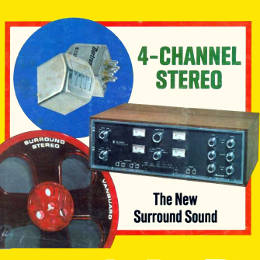Electronics World, March 1970
Updated 6 January 2024

by AudioPhil™
Audio Enthusiast & Vintage Gear Aficionado | Exploring the Past, Present & Future of Sound | #AudioTech #VintageAudio | Tap-tapping on the MPC One 🎧✨
Table of contents

Product Reviews
- Kenwood KA-6000 Stereo Amplifier tested
- Ampex AG-600-2 Tape Deck tested
Articles
- Loudspeakers, Can we measure what we hear?, by Victor Brociner
- Stop-Action Photos, by A. J. Lowe
- News - 1000 holograms in One Crystal
- News - Laser Color-TV projector
- News - computer modelled ramp-jump
- News - Electronic-Hydraulic artificial arm
- Strain gages come of ages, by Joseph Tusinski
- Low noise receiver performance measurements, by Lee R. Bishop
- 50Mhz Digital Counter, by Frank E. Cody
- Thermoluminescence Theory & Applications, by Donal E. Lancaster
Projects
- Series-Pass Regulators, by G. V. Fay
- Bandwidth Compression for efficient digital communications, by John W. Stumpe
- Low cost precision scope, by Gary H. Lehmann
- Metal boxes built to size, by Robert E. Brook
Editorial Review
The cover of this magazine should be pleasing to both the audio historian and the DIY crowd. The 1970s saw the boom in Hi-Fi equipment and interest in all things Audiophile. Although, not so common now, the cover highlights 2 well made Scott loudspeakers, the Scott S-12 and Scott S-15. The test equipment shown in the background is a General Radio 1350-A assembly. The various other woofers are also Scott manufactured drivers.
The audio market was starting to transition from mono reel-to-reel players to the stereo tape players. To compensate for these issues, leading vendors were producing narrow-gap heads that are claimed to extend frequency response beyond 12kHz.
Loudspeaker Measurement
The March 1970 edition of Electronics World features Victor Brociner's insightful article on loudspeakers, asking the pivotal question: Can we truly measure what we hear? As an assistant to the President at H. H. Scott, Inc., Brociner delves into the complexities of speaker measurements, highlighting a novel reverberant-room technique. This approach aims to provide objective, meaningful measurements that can accurately predict a loudspeaker's performance in a typical home setting. The article explores various aspects of acoustic environments, including the impact of reflecting surfaces on bass frequencies, the role of multiple reflections, and the subjective nature of what we hear. It also discusses the use of a reverberation chamber in testing, underscoring the challenge of correlating technical measurements with the human auditory experience in speaker technology.
I discuss my experience using lousdpeaker measurement equipment in my article on loudspeaker design software.
Kenwood KA-6000 Stereo Amplifier
The Electronics World March 1970 issue features a comprehensive review of the Kenwood KA-6000 Stereo Amplifier by Hirsch-Houck Labs. This high-power amplifier, conservatively rated at 45 watts per channel, boasts low distortion, control flexibility, and attractive styling. Its front panel is dominated by a large volume control knob with integrated channel balancing, and switch-type bass and treble tone controls. The input selector accommodates various sources, indicated by blue lights. The amplifier also features a speaker-output selector, headphone jack, and convenient piano-key switches for volume reduction and tone adjustments. Notably, it includes low and high-frequency filters with 12-dB-per-octave slopes. The rear panel offers a center-channel output and a preamplifier to power amplifier signal path with jumper plugs for connecting additional accessories. Laboratory measurements reveal its conservative power rating, delivering excellent performance across various loads with exceptionally low distortion and noise levels. Priced at $249.95 in 1970 USD, the Kenwood KA-6000 is a handsomely styled and highly flexible amplifier, offering great value at the time of release.
We are searching for vintage equipment
We are always on the lookout for vintage Hi-Fi equipment and related items. These items (in alphabeltical order) are that are listed in the magazine are of particular interest to us.
- Ampex 755 Stereo reel-to-reel tape deck
- Ampex 761 Portable stereo reel-to-reel tape system
- Ampex 1455 Automatic revers stereo reel-to-reel tape deck
- Ampex 2161 Ultra-portable stereo reel-top-reel tape system
- "Enjoy Music More" Course, by H. H. Scott and published by Project Publications, Inc., New York, N.Y.
- Scott S-12 Loudspeaker
- Scott S-15 Loudspeaker
- Stereo Review’s "Stereo Test Record"
References
- Electronics World, March 1970, Archive.org


